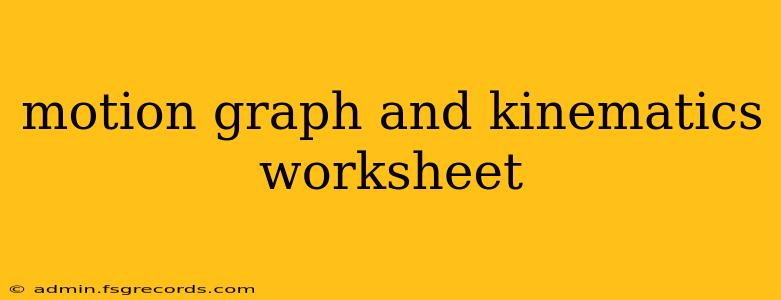Understanding motion is fundamental to physics, and mastering the interpretation of motion graphs and the application of kinematic equations is crucial for success. This worksheet will guide you through key concepts, providing practice problems to solidify your understanding of motion graphs and kinematics. We'll explore displacement, velocity, acceleration, and how they are visually represented and mathematically calculated.
Understanding Motion Graphs
Motion graphs are visual representations of an object's movement over time. The most common types are:
-
Position-Time Graphs: These graphs plot an object's position (displacement) on the y-axis against time on the x-axis. The slope of the line represents the object's velocity. A positive slope indicates motion in the positive direction, a negative slope indicates motion in the negative direction, and a zero slope indicates the object is at rest.
-
Velocity-Time Graphs: These graphs plot an object's velocity on the y-axis against time on the x-axis. The slope of the line represents the object's acceleration. A positive slope indicates positive acceleration (speeding up), a negative slope indicates negative acceleration (slowing down), and a zero slope indicates constant velocity. The area under the curve represents the object's displacement.
-
Acceleration-Time Graphs: These graphs plot an object's acceleration on the y-axis against time on the x-axis. The area under the curve represents the change in velocity.
Interpreting Motion Graphs: Practice Problems
-
Scenario: A car travels at a constant speed of 20 m/s for 5 seconds, then stops instantaneously. Sketch the position-time and velocity-time graphs for this motion. What is the total displacement of the car?
-
Scenario: A ball is thrown vertically upwards. Describe the shape of the velocity-time graph for the ball's motion from the moment it leaves the hand until it returns to the hand. What does the area under the curve represent?
Kinematics Equations
Kinematics equations allow us to mathematically describe motion. These equations relate displacement (Δx), initial velocity (v₀), final velocity (v), acceleration (a), and time (t). The most commonly used equations are:
- v = v₀ + at (Final velocity)
- Δx = v₀t + (1/2)at² (Displacement)
- v² = v₀² + 2aΔx (Final velocity squared)
- Δx = (v + v₀)/2 * t (Displacement – constant acceleration)
Applying Kinematic Equations: Practice Problems
-
Scenario: A car accelerates from rest at a constant rate of 2 m/s² for 10 seconds. What is its final velocity and how far does it travel during this time?
-
Scenario: A ball is thrown vertically upwards with an initial velocity of 15 m/s. If the acceleration due to gravity is -9.8 m/s², how long does it take to reach its maximum height? What is its maximum height?
-
Scenario: A train decelerates from 30 m/s to 10 m/s over a distance of 200 meters. What is its acceleration?
Connecting Graphs and Equations
It’s essential to understand that motion graphs and kinematic equations are interconnected. You can use information from a graph to solve for unknowns using the kinematic equations, and conversely, you can use the kinematic equations to predict the shape of a motion graph.
Combining Graphs and Equations: Practice Problem
- Scenario: A position-time graph shows a parabolic curve. What can you infer about the object's acceleration? Write a kinematic equation that describes this motion, assuming you know the initial velocity and acceleration.
This worksheet provides a foundation for understanding motion graphs and kinematics. Remember to practice regularly to solidify your comprehension. Further exploration of more complex scenarios involving projectile motion and two-dimensional motion will build upon these foundational concepts.

